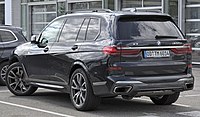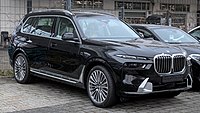The BMW X7 is a full-sized luxury crossover sport utility vehicle manufactured by BMW. It is BMW's largest and 2nd most expensive SUV in its line-up.[3]
| BMW X7 | |
|---|---|
 | |
| Overview | |
| Manufacturer | BMW |
| Model code | G07 |
| Production | December 2018 – present[1] |
| Model years | 2019–present |
| Assembly |
|
| Designer | Julien Sarreméjean[2] Anders Thøgersen (facelift) |
| Body and chassis | |
| Class | Full-size luxury crossover SUV |
| Body style | 5-door SUV |
| Layout | Front-engine, all-wheel drive (xDrive) |
| Platform | Cluster Architecture (CLAR) |
| Related | |
| Powertrain | |
| Engine | |
| Transmission | 8-speed ZF 8HP automatic |
| Dimensions | |
| Wheelbase | 3,105 mm (122.2 in) |
| Length | 5,151–5,181 mm (202.8–204.0 in) |
| Width | 2,000 mm (78.7 in) |
| Height | 1,805–1,835 mm (71.1–72.2 in) |
| Curb weight | 2,320–2,460 kg (5,115–5,423 lb) |
The X7 was first announced by BMW in March 2014.[4] It was officially unveiled on October 17, 2018, with pre-orders being taken online. The X7 has been available at dealers since March 2019.[5]
Launch and development
BMW provided a preview of the upcoming X7 with the showing of the Concept X7 iPerformance at the 2017 International Motor Show in Frankfurt.[6] Production of the X7 started in 2018 at the BMW US Manufacturing Company plant in Greer, South Carolina.
The X7 is built on the same BMW CLAR platform as the G05 X5, however the X7 is taller and wider plus it has been stretched for increased cargo space and third row seating which is standard and more spacious for adults (the X5's third row seating, which is optional, is mainly for children).[7] In contrast to the X5, it is not available with rear-wheel drive, instead using an all-wheel drive (xDrive) drivetrain for all models. In Europe, diesel and petrol engines are available, while the choice is limited to inline-6 and V8 petrol engines in the United States.[8]
The G07 features a self-levelling air suspension system, with a double-wishbone front suspension and multi-link rear suspension.[9] It can be raised or lowered by 40 mm (1.6 in) and will automatically lower the car by 20 mm (0.8 in) at speeds of over 138 km/h (86 mph).[10] The boot capacity is rated at 326 litres (11.5 cu ft), and 2,120 litres (75 cu ft) with the seats folded down.[11]
All petrol and diesel models feature engine particulate filters and meet the Euro 6d-TEMP emissions standard.[12] The xDrive50i model is available outside the European markets, while the European markets will get the M50i models.[13]
In July 2019, a pickup truck concept car was unveiled, though not intended for production.[14]
- 2020 BMW X7 M Sport
- 2020 BMW X7 M50d
- 2019 BMW X7 xDrive40i
- 2021 Alpina XB7
- Interior (pre-Facelift)
Facelift
In April 2022, BMW unveiled a new revised X7, which entered production in July and was launched the following month. The design is very similar to the original first generation design, with minimal changes to the side profile and rear. The major changes are a heavily revised front end design premiering new "horizontally split headlight units" and a revised curved widescreen focused dashboard within an otherwise largely unchanged interior. It is widely thought that the aesthetic function of the horizontally split headlights is to increase the proportion of the front design dedicated to the headlights relative to very large kidney grill. The new headlights were also featured on the new 7 Series and i7.[15]
- 2022 BMW X7
- 2022 BMW X7 with M Sport Package
- 2022 BMW X7
- 2022 BMW X7 M60i xDrive
Equipment
The G07 X7 is available in Design Pure Excellence, Sport and M Sport trims.[16]
Standard equipment includes Vernasca leather, four-zone climate control, iDrive 7.0, Adaptive LED headlights, wireless charging,[17] and electrically adjustable and heated three row seating. The middle row features three seats with a two-seat configuration also available.[18] The X7 also receives driver assistance systems including autonomous cruise control and collision detection with braking intervention.[19] Other options include cooled and heated cup holders, a panoramic sunroof with LED light patterns, and laser headlights.[20] An off-road package adds selectable off-road driving modes and adjusts the ride height, acceleration and transmission response, and traction control system.[21]
The instrument cluster features a camera to ensure the driver is paying attention to the road while autonomous functions are active,[22] and allows the driver to take their hands off the steering wheel for up to one minute. Additionally it has an optional heads up display that shows a clear map with navigation instructions, in addition to speed.[23]
30-40 models with the M Sport trim and M50 models can be fitted with M Performance Parts. These include carbon fibre mirrors, a sport steering wheel, floor mats and steel pedals.
Models
Petrol engines
| Model | Years | Engine- turbo | Power | Torque | 0–100 km/h (0–62 mph) |
|---|---|---|---|---|---|
| xDrive40i | 2018–2022 | 3.0 L B58 straight-6 | 250 kW (335 hp) at 5,500–6,500 rpm | 450 N⋅m (332 lb⋅ft) at 1,500–5,200 rpm | 5.8 s |
| xDrive40i | 2023– | 280 kW (375 hp) at 5,500–6,500 rpm | 520 N⋅m (384 lb⋅ft) at 1,500–5,200 rpm | 5.6 s | |
| xDrive50i | 2018–2020 | 4.4 L N63 V8 | 340 kW (456 hp) at 5,250–6,000 rpm | 650 N⋅m (479 lb⋅ft) at 1,500–4,750 rpm | 5.4 s |
| M50i | 2019–2022 | 390 kW (523 hp) at 5,500–6,000 rpm | 750 N⋅m (553 lb⋅ft) at 1,800–4,600 rpm | 4.5 s | |
| M60i | 2023– | 4.4 L S68 V8 | 390 kW (523 hp) at 5,500–6,000 rpm | 750 N⋅m (553 lb⋅ft) at 1,800–4,600 rpm | 4.7 s |
| Alpina XB7 | 2020– | 4.4 L N63 V8 | 457 kW (613 hp) at 5500–6600 rpm | 800 N⋅m (590 lb⋅ft) at 2,000–5,000 rpm | 4.2 s |
Diesel engines
| Model | Years | Engine- turbo | Power | Torque | 0–100 km/h (0–62 mph) |
|---|---|---|---|---|---|
| xDrive30d | 2018– | 3.0 L B57 straight-6 | 195 kW (261 hp) at 4000 rpm | 620 N⋅m (457 lb⋅ft) at 2000–2500 rpm | 7.0 s |
| xDrive40d | 2020– | 250 kW (335 hp) at 4400 rpm | 700 N⋅m (516 lb⋅ft) at 1750–2250 rpm | 6.1 s | |
| M50d[24] | 2018–2020 | 3.0 L B57 straight-6 | 294 kW (394 hp) at 4400 rpm | 760 N⋅m (561 lb⋅ft) at 2000–3000 rpm | 5.4 s |
See also
References
External links









